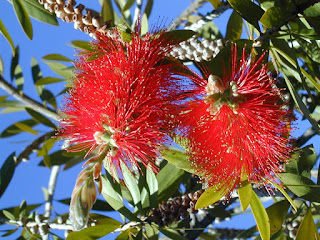PAPERBARK
- The Paperbarks, Melaleuca spp., are one of the most distinctive Australian plants, usually well known both to residents and many visitors alike.
- They are also known as 'honey myrtles' as many species produce copious amounts of nectar, and as 'Tea-trees', although this name is more commonly used for the other Myrtaceae genus Leptospermum.
- Melaleucas are also often mistaken at first glance for Eucalyptus trees. They are in a separate genus, but in the same family, and many of the species share the familiar pendulous branches and drooping leaves.
- Other common family features are the aromatic, oil gland filled leaves and the flowers dominated by many colourful stamens (above right). And, as is obvious from the main common name, many species have peeling, papery bark (above left).
- In this genus, the stamens are united into bundles, of which there are five in every individual flower (Holliday 1989).
- There are at least 200 different species of Melaleuca. Most of these are found in Australia, but there are a few extending up into tropical Asia and several can be seen in the Daintree region. In fact, in some of the areas around the Daintree coastal floodplains, they constitute their very own ecosystems of 'Paperbark Swamps'.
- Paperbarks have several different uses for humans. The peeling bark was not used as paper, but it was used as a material in which the Australian Aboriginals would cook. In modern times, the famous 'tea-tree' oil is in fact derived from a Melaleuca. It's anti-bacterial qualities derive from terpenic-type oils in the species Melaleuca alternifolia.
COFFEE PLANT
- This is one of the largest of all flowering plant families, with over 6000 species, found mostly in the tropics of the world (Perry 1977).
- With so many species, variability in features should be expected.
- However, the leaves are usually either opposite to the stem, or arranged in whorls (Jackes 1997).
- Many specimens will have a scar on the stem, which appears as a line between the two opposite leaves where there was previously a stipule.
- The flowers in this family vary from the pretty white twisted petals of Gardenias to the Ixora that have their tiny bright red flowers grouped in a head.
- The following fruits are often small round red berries, often larger compound fruits. As the ovary is inferior, that is, it is located below the petals and sepals, the fruits often develop with the presence of a calyx ring.
- This is an economically important family as it contains the much loved Coffee plants, and the early treatment and prevention against malaria, the quinine plant.
- There are also many ornamentals from this family, such as the Gardenias, with their pretty and fragrant flowers.
STRIPED CUCUMBER
- This is a thin-stemmed twiner. The fruits are very distinctive minature watermelon like fruits, that start green with white blotched stripes and ripen to bright red orange.
- They have many small whitish seeds and are toxic.
- They are very widespread, found in wetter forests throughout tropical australia, asia, the Pacific and Africa.
WALKING STICK PALM
- Walking Stick Palms are small plants, with fishtail-like leaves.
- They produce small, colourful red or orange fruits that resemble tic-tacs. The fruits pictured belong to the Northern Walking Stick Palm Linnopadix minor.
- They have large seeds, but the little flesh they do have is edible.
- The 'Walking Stick Palms' are so-named as the southern species from the sub tropical rainforests in northern NSW and southern Queensland was once used for walking sticks.
EUCALYPTUS
Eucalypts, commonly known as gum trees, form an integral part of the Australian identity with the bush. From the children's song Kookaburra sits in the old gum tree through to the distinctive smell of eucalypts to iconic paintings and photographs, eucalypts are an essential part of Australian culture, featuring in art, music and literature.The sight and smell of eucalypts are a defining part of Australian life. The sight of the blue haze from the eucalyptus oil arising from the bush in the mountain ranges west of Sydney gave the Blue Mountains their name.
If you want to learn more about Australia's flora, you can search for information here:









No hay comentarios:
Publicar un comentario